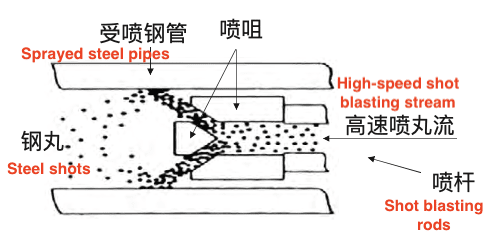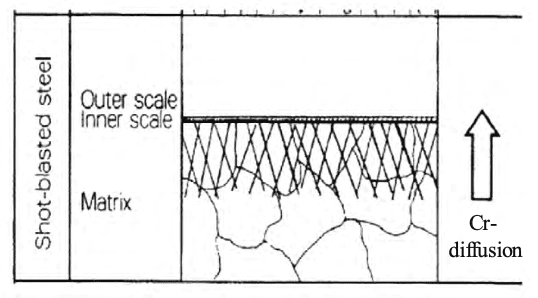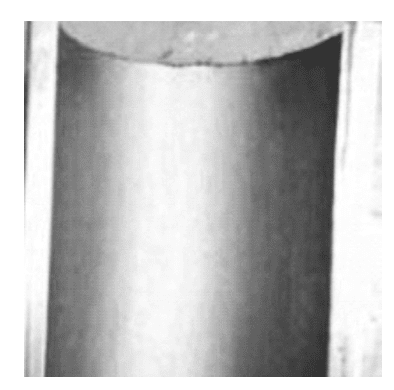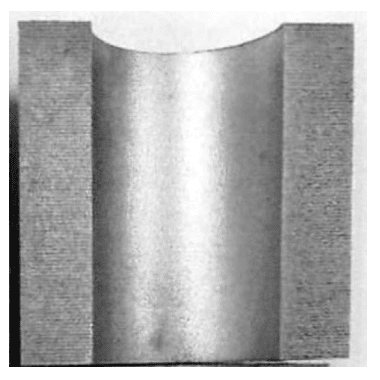Abstract: The factors affecting the performance of shot blasting inside the
austenitic stainless steel boiler tube were analyzed; the influence of comparative experiments on various process parameters was designed, and the analysis and research were carried out. According to the analysis results, suggestions are put forward for internal shot blasting with good high-temperature corrosion resistance, stable shot blasting effect and high production efficiency.
High-temperature oxidation corrosion of the inner wall is one of the main factors for the failure of boiler tubes in supercritical power plants.
To improve the service life of boiler tubes and meet the higher and higher requirement for steam temperatures, the measures currently taken include using materials with better corrosion resistance, improving the structure and properties of materials, and using technical means to treat the surface, reduce the diffusion speed difference between Fe element and Cr element, and form a dense Cr oxide film layer at high temperature. The oxidation resistance of steel pipes is improved through internal shot blasting, which is being used more and more in the power station industry at home and abroad.

Figure 1 The schematic diagram of shot blasting on inner walls of steel pipes

Figure 2 The schematic diagram of the Cr element diffusion channel in the shot blasting layer on the inner wall of the steel pipe
SA213M S30432 austenitic stainless steel boiler tube is currently the main material for super (ultra) critical boiler superheater and reheater and other high-temperature components due to its excellent high-temperature creep and high-temperature oxidation resistance. The S30432 austenitic stainless steel boiler tubes studied in this paper are manufactured by a steel factory and have been widely used by major domestic boiler manufacturers.
1.
Analysis of the principle
The main mechanism for improving the oxidation resistance of boiler tubes through internal shot blasting is as follows:
(1) The difference in diffusion speed between Fe and Cr is an important factor affecting the composition of the surface oxide film. The high-temperature oxide film formed in the super critical power plant boiler tube at 600°C is mainly composed of Fe3O4 and (Fe, Cr)3O4. Compared with Fe2+ and Fe3+, the diffusion rate of Cr3+ to the oxide film or gas interface is much slower. The farther away from the oxide film or substrate interface, the smaller the Cr concentration becomes, resulting in the outermost layer of the oxide film being iron oxide. The iron oxide continues to grow and peel, resulting in accelerated corrosion of the inner wall. The diffusion of Cr is mainly realized by short-circuit diffusion. Internal shot blasting can refine the surface grains, form high-density dislocations and stacking fault structures, increase short-circuit diffusion channels such as grain boundaries and sub-grain boundaries, and improve the Cr diffusion flux (Figure 2), forming a Cr-rich oxide layer, changing the composition of the surface oxide film, and reducing the corrosion rate.
(2) In the high-temperature oxidation environment containing water vapor, the oxidation process of Fe-Cr alloy is significantly accelerated, mainly because the water vapor molecules adsorbed on the surface of the oxide film react with Fe ions from the oxidation interface of the inner and outer layers to generate FeO and free hydrogen; hydrogen can significantly accelerate the decomposition of iron-chromium oxide film. After shot blasting, the original oxide film layer is uniform and dense, which can slow down the reaction rate of H2O and iron chromium oxide.

From the above analysis, it can be concluded that the greater the effective depth of the shot blasting layer in the boiler tube is, the denser the original oxide film layer becomes; the more uniform and refined the grains are, and the better the high-temperature corrosion resistance becomes. At present, the main methods for evaluating the depth, microstructure, corrosion resistance and other properties of the inner shot blasting layer of steel pipes are metallographic methods and microhardness methods. Two methods are used to obtain the S30432 boiler tube through different inner shot blasting in this article. The sample tube is studied to select a more reasonable process and improve the quality of the inner shot blasting layer.
1.
Process design
The basic parameters of the shot blasting equipment used are that the design maximum working pressure is 1.4 MPa, the shot blasting flow rate 10 to 20 kg/min, the automatic feeding speed of the spray gun 20 to 100 cm/min; the speed of the shot blasting traveling trolley 0.2 to 3 m/min; the shot material is special 304 stainless steel shot, and the particle is 0.3 mm to 0.7 mm. The object of shot blasting is 51 mm × 11 mm S30432 austenitic stainless steel boiler tube; after hot extrusion and cold rolling, the inner surface is clean and free of defects (Figure 3); after shot blasting, the inner surface is clean and free of mechanical damage, and the shot blasting layer is uniform (Figure 4).

Figure 3 The state of inner surfaces of steel pipes before shot blasting

Figure 4 The state of inner surfaces of steel pipes after shot blasting
Different shot blasting processes were designed for experiments, and the effects of working pressure, spray gun feeding speed, projectile flow rate, and shot blasting times on the results were tested. Metallographic inspection and cross-section hardness curve analysis are carried out on the samples with good effect to verify whether the depth of shot blasting layer and the change value of hardness meet the standard requirements.
Table 1 Parameters of shot blasting tests
| Items |
Working pressure/MPa |
Spray gun feeding speed (/ cm.min-1) |
Projectile flow rates (/ kg.min-1) |
Shot blasting times |
| 1-1 |
1.0 |
50 |
15 |
2 |
| 1-2 |
1.25 |
50 |
15 |
2 |
| 1-3 |
1.40 |
50 |
15 |
2 |
| 2-1 |
1.25 |
35 |
15 |
2 |
| 2-2 |
1.25 |
70 |
15 |
2 |
| 3-1 |
1.25 |
50 |
11 |
2 |
| 3-2 |
1.25 |
50 |
18 |
2 |
| 4-1 |
1.25 |
50 |
15 |
1 |
| 4-2 |
1.25 |
50 |
15 |
3 |





